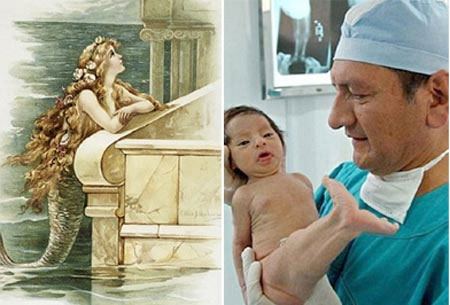Decode the mermaid phenomenon in real life
According to legend, half-human and half-fish creatures appeared for the first time in the ancient Assyria kingdom (now Syria) when the goddess Atargatis transformed himself into a fisherman because he felt guilty after accidentally killing his lover. mine.
>>> Anew question about the "Mermaid" is true in history
Historically, these mesmerizing creatures have been linked to disasters, disasters in Europe, Africa and Asia, including floods, storms, shipwrecks and drowning.
The mermaids are also portrayed in many books, pictures, movies and plays, including the famous fairy tale "Little Mermaid" by Danish writer Hans Christian Andersen.

The mermaid in literary, artistic and cinematographic works is thought to have originated in a real-life phenomenon.
Some experts say that mermaid ideas may stem from a real life disease.Sirenomelia is also known as "Mermaid syndrome" is a life-threatening disease, characterized by the rotation and melting of the patient's feet. This is a rare birth defect, making the sick person look like there is a genus of fishtail from the fetus.
Medical historian Dr. Lindsey Fitzharris said "Mermaid syndrome" occurs due to problems in the vascular system, when the umbilical cord does not form two arteries. Consequently, there is not enough blood supply to the fetus. The only artery "stealing" blood and nutrients from the lower body, diverting them back to the placenta. Due to lack of nutrition, the fetus does not develop two legs separately.
However, this disease is extremely rare, only an average of 1 in 100,000 babies, but an increase of 100 times the risk of twins and eggs. Children born with "Mermaid syndrome" rarely live more than a few days after birth with half of deaths soon after birth.
Dr. Fitzharris, author of The Chirurgeon's Apprentice blog, added: "During the study, I found very little information about the history of the disease. There is also some information that claims, the The fetus with sirenomelia is occasionally stored in storage bottles and displayed on horror shows in the 19th century. However, these sources are obscure to the point of discomfort. "

The skeleton and fetal samples with "Mermaid Syndrome" are being kept at the Vrolik Museum in the Netherlands.
According to historian Fitzharris, a 4-volume atlas published in 1891 entitled "Strange deformities in humans" briefly refers to sirenomelia, but does not reveal the fact that such ancient doctors know it. What about this disease? However, this researcher found a fetus with "Mermaid syndrome" in the early 20th century at the US National Museum of Medicine and Pharmacy and 3 other similar fetal malformations, went through simulation of 3D bone reconstruction, at the Anatomy Museum of the University of Naples No. 2 (Italy).
However, according to Dr. Fitzharris, the largest sirenomelia fetal collection is now in Vrolik Museum (Amsterdam, Netherlands). They are among more than 5,000 preserved samples of human and animal defects in the areas of anatomy, pathology, embryology and birth defects.
Dr. Fitzharris added that there is no record of any cases of "Mermaid syndrome" that survived in the past. Most patients die within a few days after birth due to kidney or intestinal failure. Even today, the number of children who are able to resist this evil monster is also extremely small, with a few cases surviving the neonatal period.
In 1988, Tiffany Yorks underwent a 2-leg splitting procedure before her first birthday in her life. At the age of 26, she is currently the one with the most severe illness of sirenomelia ever. Even so, Tiffany still has some problems with movement due to fragile bones, and is forced to use crutches and wheelchairs to go there.

The Peruvian "Little Mermaid" stood and walked after the second surgery at 2 years old.
Another well-known case of survival is a Peruvian girl with the nickname "Little Mermaid" , with two legs attached from her groin to her knees and two flat legs, spread out. In 2006, a group of 8 experts conducted a successful second surgery in 2-year-old fish girl Milagros Cerron, helping her to gradually be able to stand alone without help. and can take small steps to support.
In 2006, doctors calculated that Milagros should continue to undergo at least 16 more surgeries in the next decade to reestablish and reconstruct digestive organs, excreting urine and genitalia also suffer from axes. her innate malfunction.
- The new question about 'The Mermaid' is true in history
- Legend and reality about fishmen
- Decode real damage 'phenomenon' who ignites like a fireball
- Mysterious mermaid in the Greenland Sea?
- Unique mermaid photo set
- The mummified corpses of 'mermaids'
- The legendary mermaid statue is 100 years old
- Is the world in Avatar real?
- The unborn child grows like a mermaid in the womb
- The phenomenon of 'seeing heaven' through the words of the dead goes back to life
- Scientific evidence that reincarnation is real
- Secret mummy monkey head, I fish
 Green tea cleans teeth better than mouthwash?
Green tea cleans teeth better than mouthwash? Death kiss: This is why you should not let anyone kiss your baby's lips
Death kiss: This is why you should not let anyone kiss your baby's lips What is salmonellosis?
What is salmonellosis? Caution should be exercised when using aloe vera through eating and drinking
Caution should be exercised when using aloe vera through eating and drinking Finding the 'mermaid mummy', the expert said a sentence that surprised everyone
Finding the 'mermaid mummy', the expert said a sentence that surprised everyone  Amazing thing about manatees 'real mermaid'
Amazing thing about manatees 'real mermaid'  The legendary mermaid statue is 100 years old
The legendary mermaid statue is 100 years old  The new question about 'The Mermaid' is true in history
The new question about 'The Mermaid' is true in history  The mummified corpses of 'mermaids'
The mummified corpses of 'mermaids'  Mysterious mermaid in the Greenland Sea?
Mysterious mermaid in the Greenland Sea? 